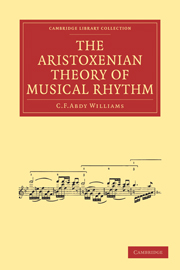Book contents
- Frontmatter
- PREFACE
- Contents
- MUSICAL ILLUSTRATIONS
- INTRODUCTION
- CHAPTER I
- CHAPTER II
- CHAPTER III
- CHAPTER IV
- CHAPTER V
- CHAPTER VI
- CHAPTER VII
- CHAPTER VIII
- CHAPTER IX
- CHAPTER X
- APPENDIX A Quotations, from original sources, of passages referred to in the text
- APPENDIX B Glossary of Technical Terms
- APPENDIX C Dactylo-epitritic, Logaœdic, and Dochmiac rhythms, and rhythmical modulation. M. Laloy's views
- INDEX
- Frontmatter
- PREFACE
- Contents
- MUSICAL ILLUSTRATIONS
- INTRODUCTION
- CHAPTER I
- CHAPTER II
- CHAPTER III
- CHAPTER IV
- CHAPTER V
- CHAPTER VI
- CHAPTER VII
- CHAPTER VIII
- CHAPTER IX
- CHAPTER X
- APPENDIX A Quotations, from original sources, of passages referred to in the text
- APPENDIX B Glossary of Technical Terms
- APPENDIX C Dactylo-epitritic, Logaœdic, and Dochmiac rhythms, and rhythmical modulation. M. Laloy's views
- INDEX
Summary
In Aristides Quintilianus and Martianus Capella, we meet with the technical term “Period.” The somewhat chequered history of this word can be found in Westphal's Allgemeine Theorie der Mus. Rhythmik, pp. 22–24. For our present requirements the period must be understood as a combination of two or more rhythms, or musical phrases, in such a manner as to form a complete idea. The two or more rhythms can be conveniently referred to as “members,” the English equivalent of the Greek technical name cola. The member may be divided into half-rhythms, the name then being semicolon, or less than a half rhythm may occur as a portion of the period; in this case it is a comma. The musical period therefore consists of a combination of cola, or colons, commas, and semicolons. Thrasymachus of Chalcedon adopted these terms for the divisions of rhetoric, and hence in course of time they came to be used for the signs marking the divisions in writing, i.e. the punctuation signs.
The period has been a fundamental principle in all ages, in prose, poetry and music. In its simplest form it has two members only, to which various names have been given. By grammarians they have been called Protasis and Apodosis; Antecedent and Consequent; by musicians, first phrase and second phrase; in German Vordersatz and Nachsatz; the first member or rhythm making, as it were, a statement, and the second confirming or completing it.
- Type
- Chapter
- Information
- The Aristoxenian Theory of Musical Rhythm , pp. 107 - 126Publisher: Cambridge University PressPrint publication year: 2009First published in: 1911

